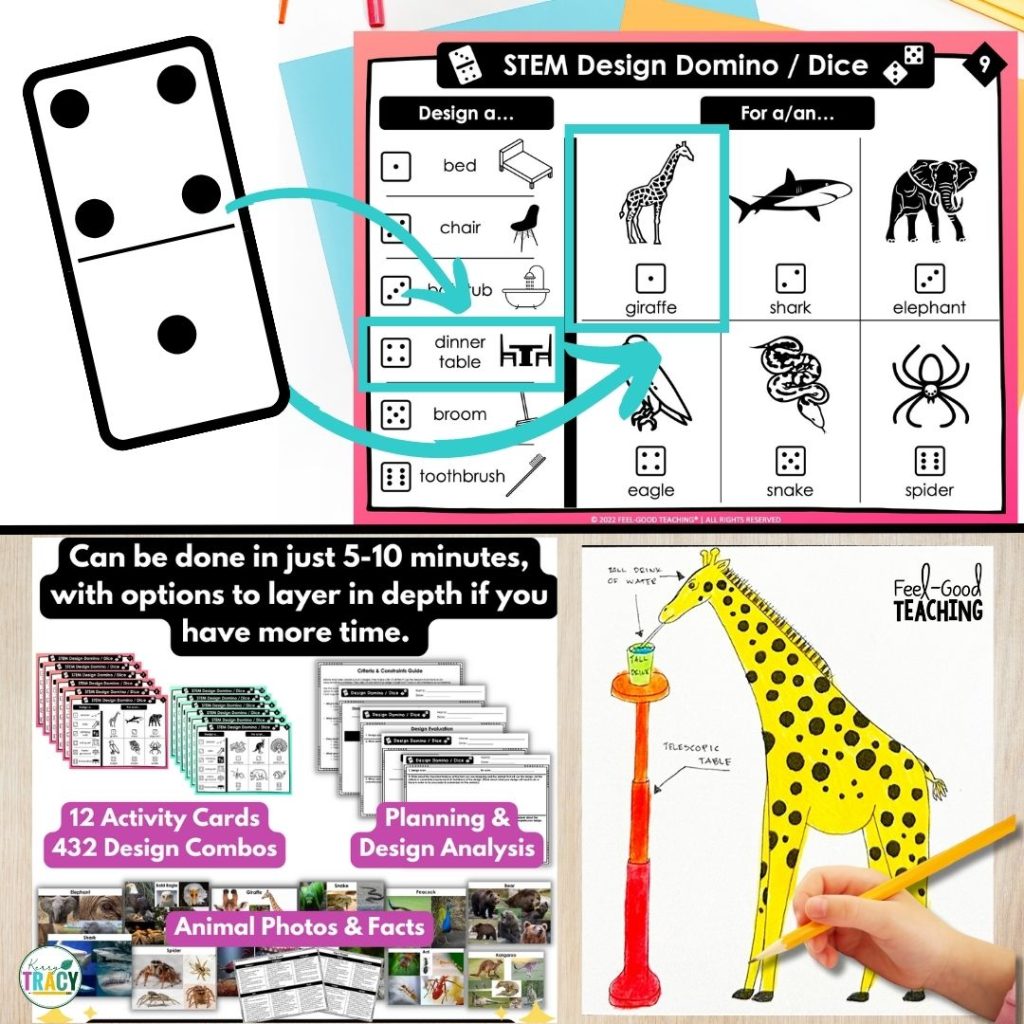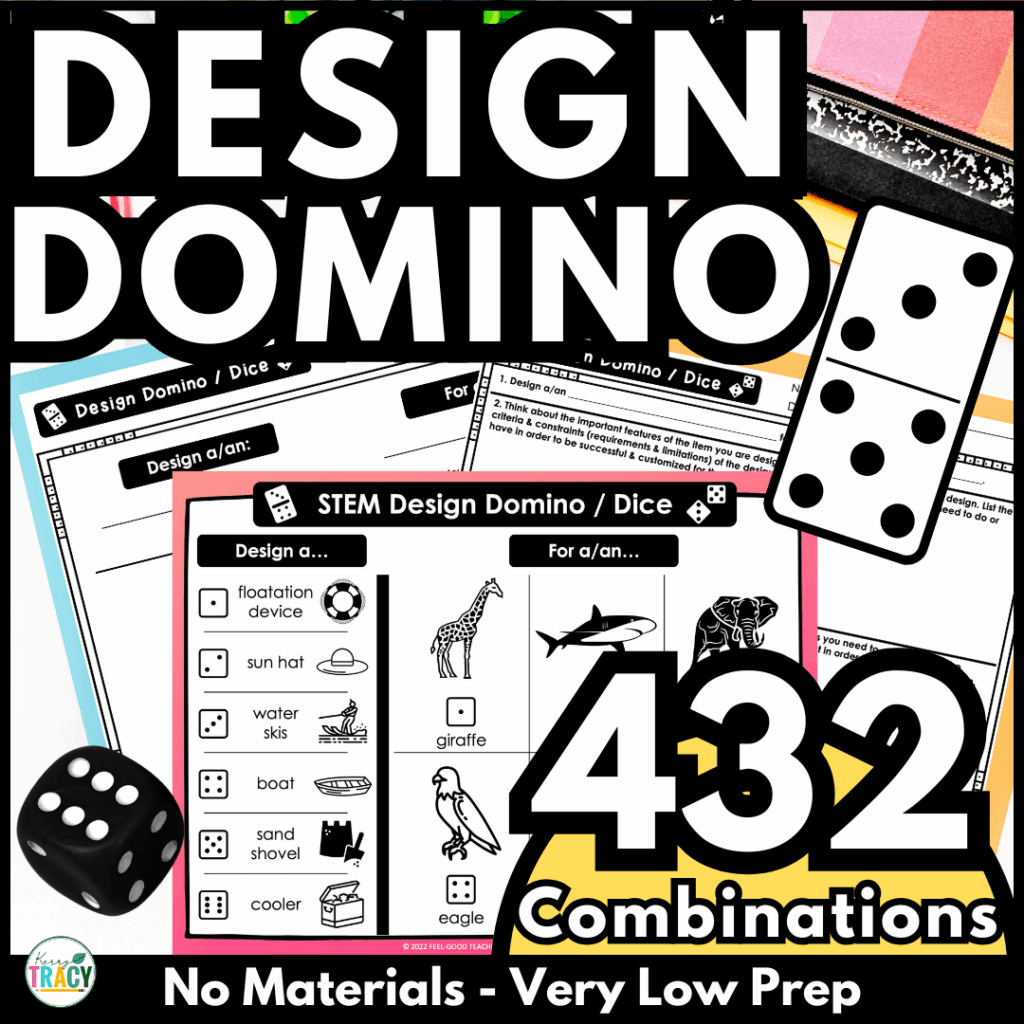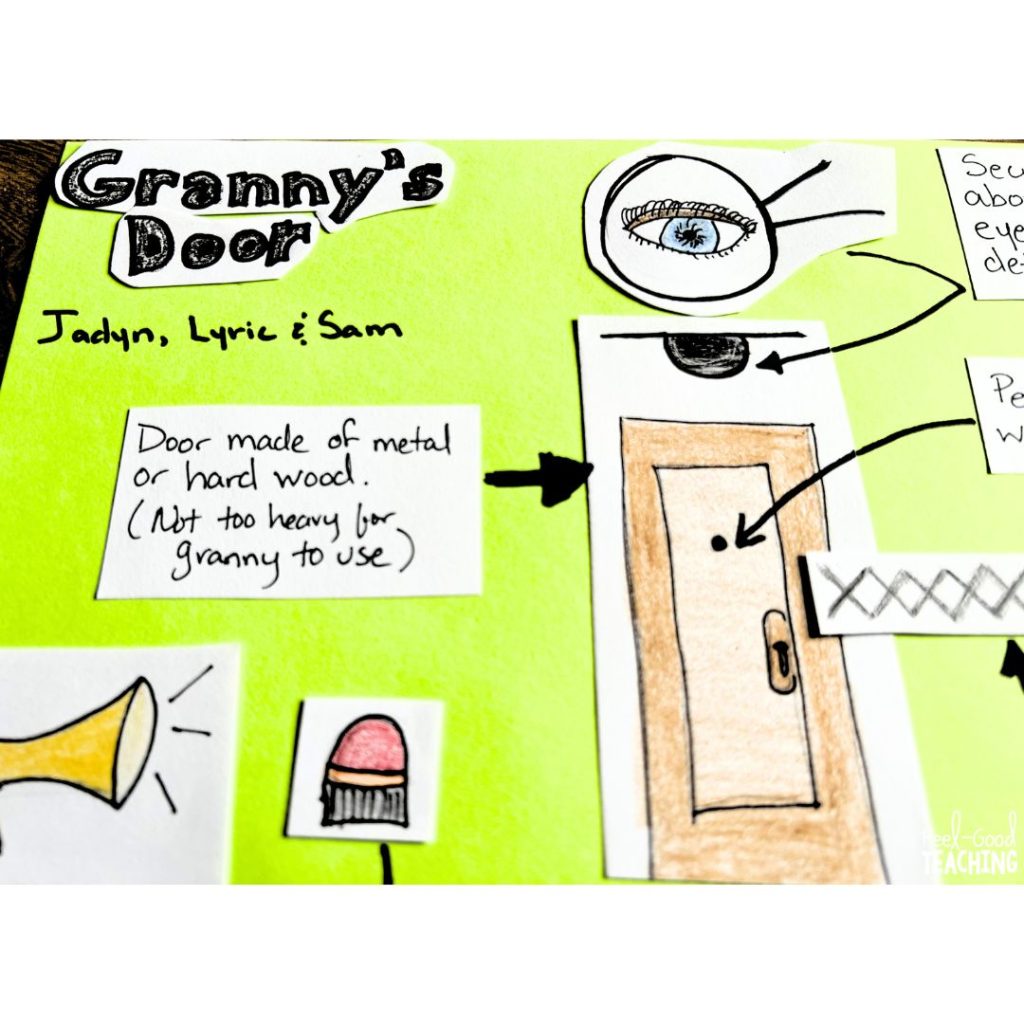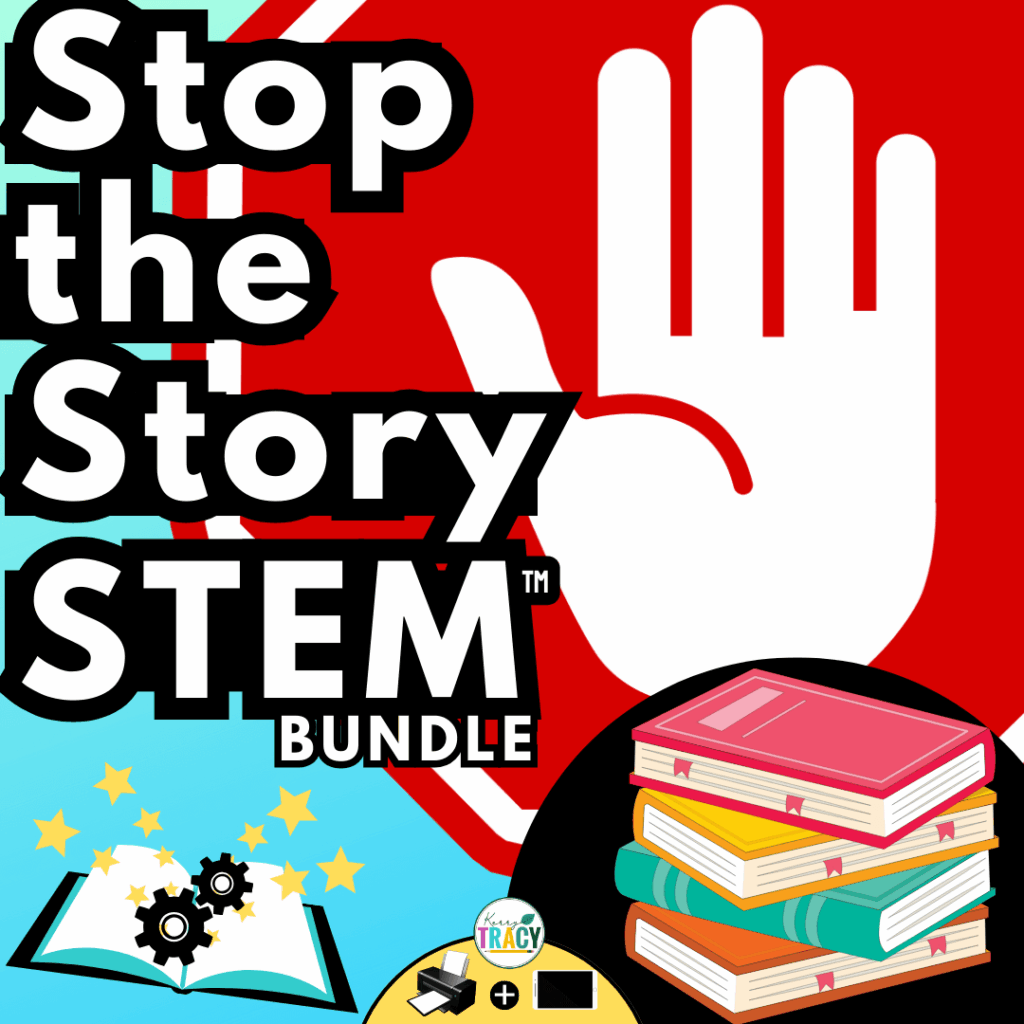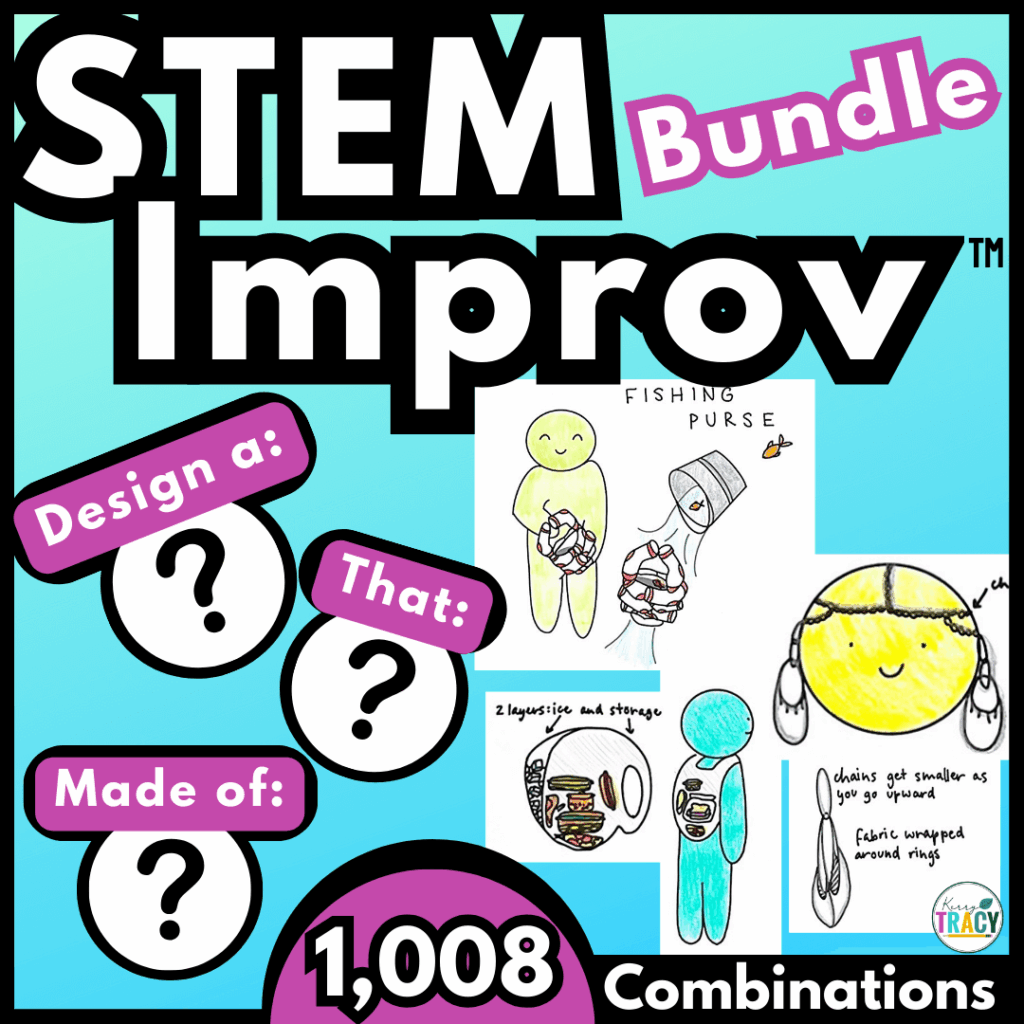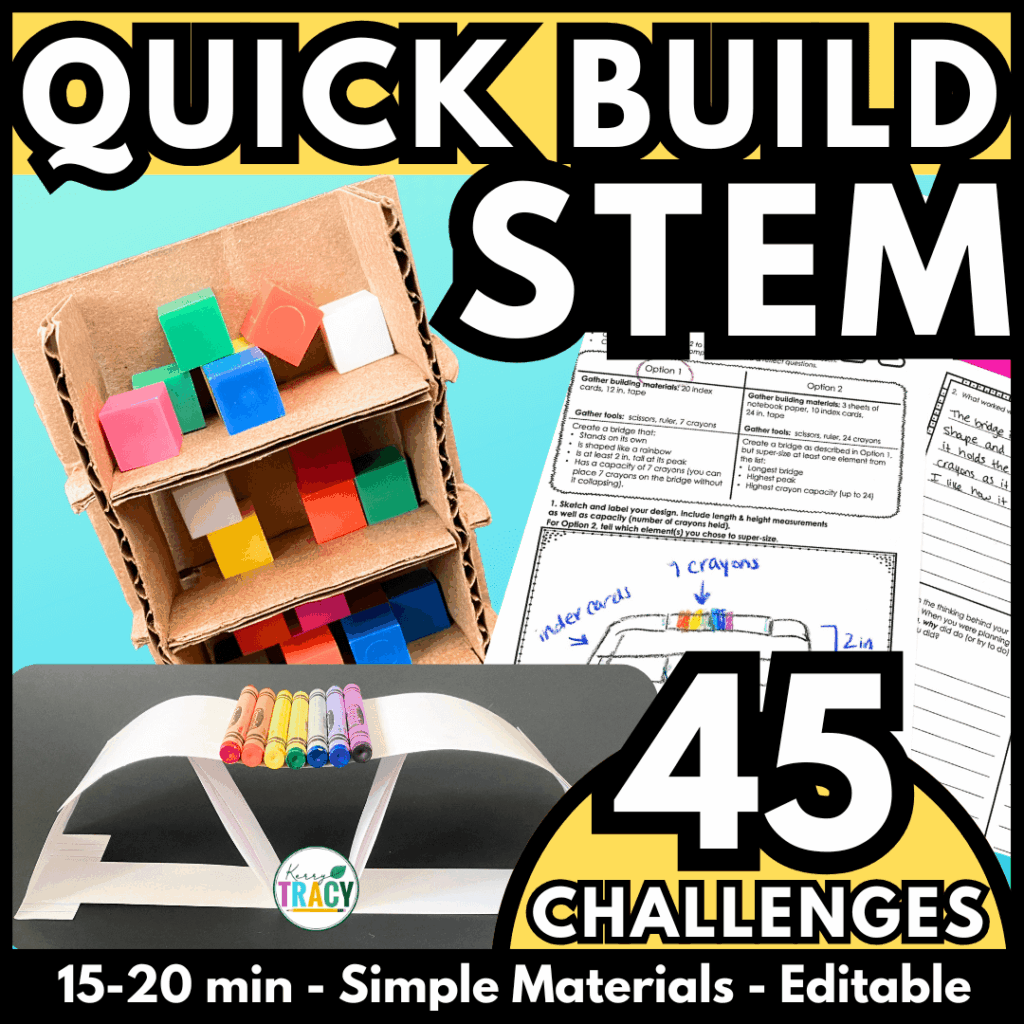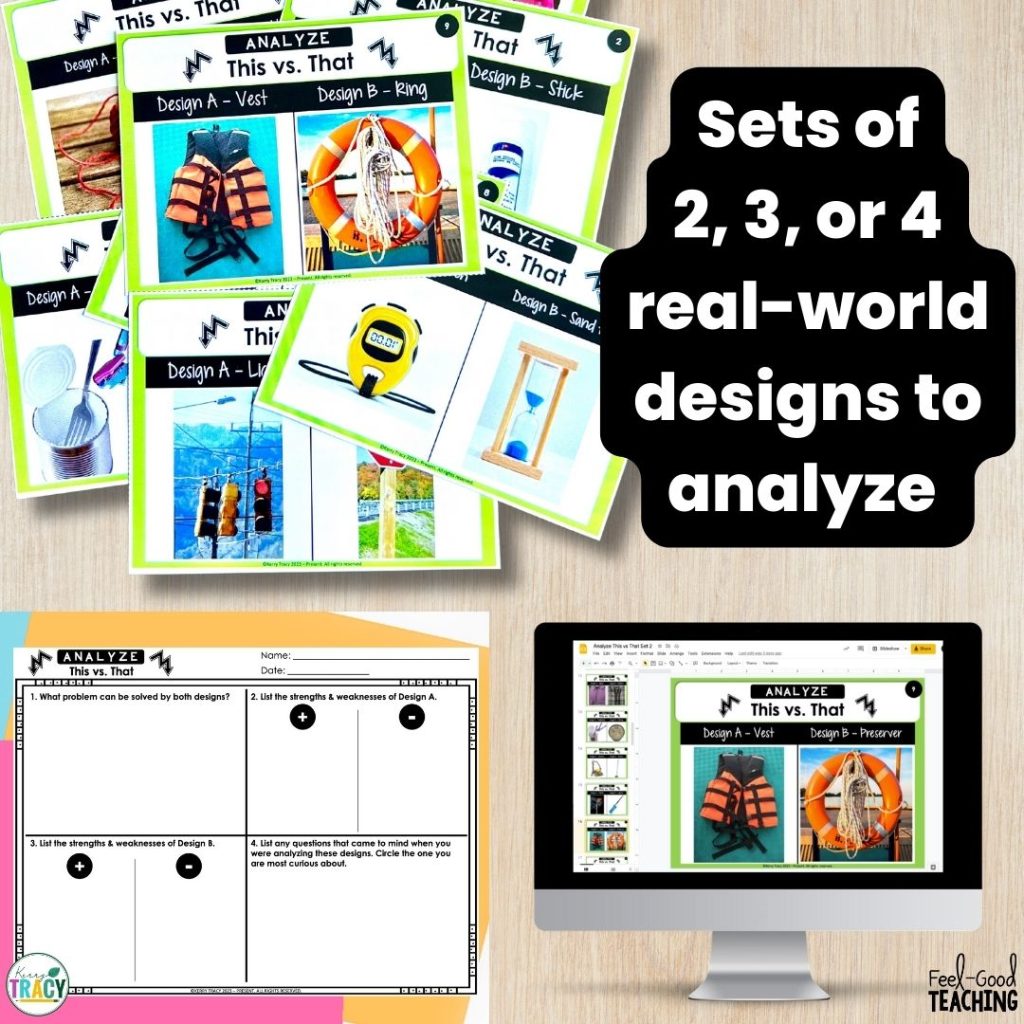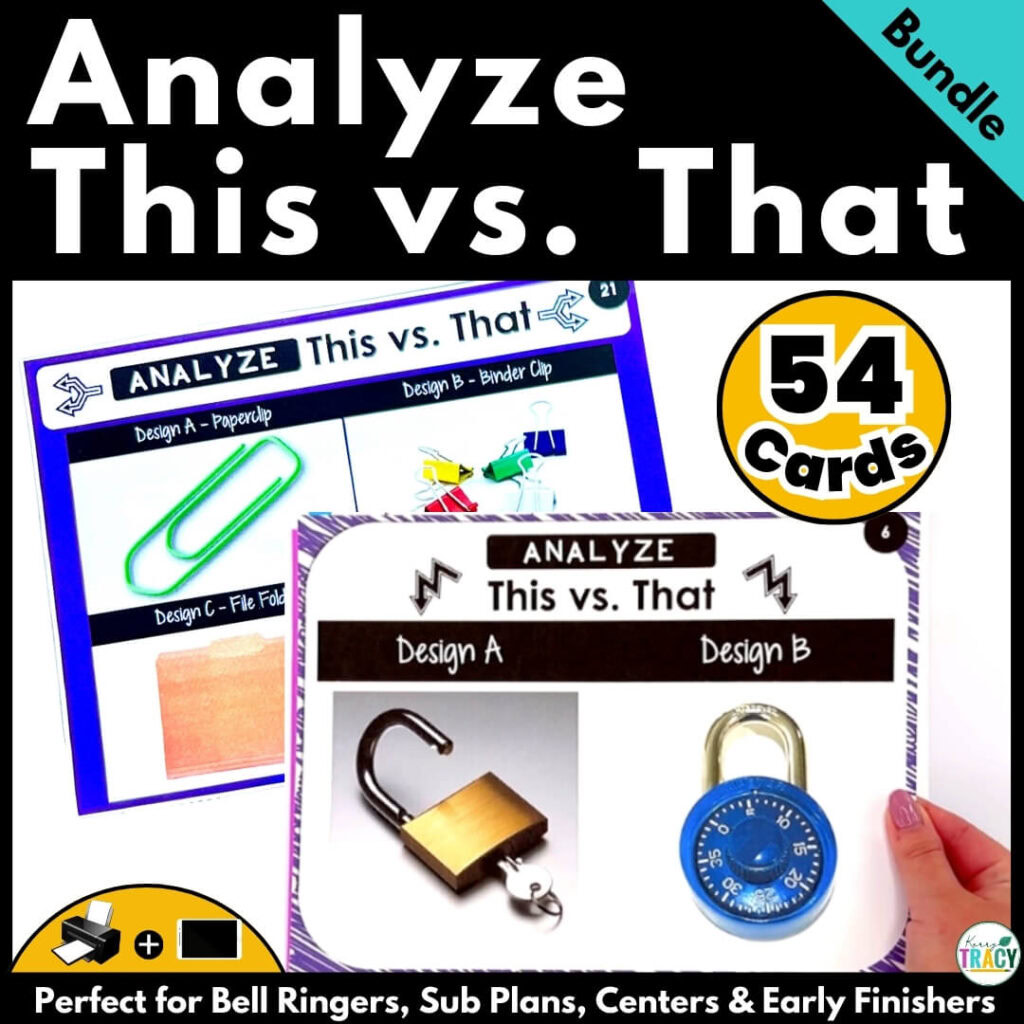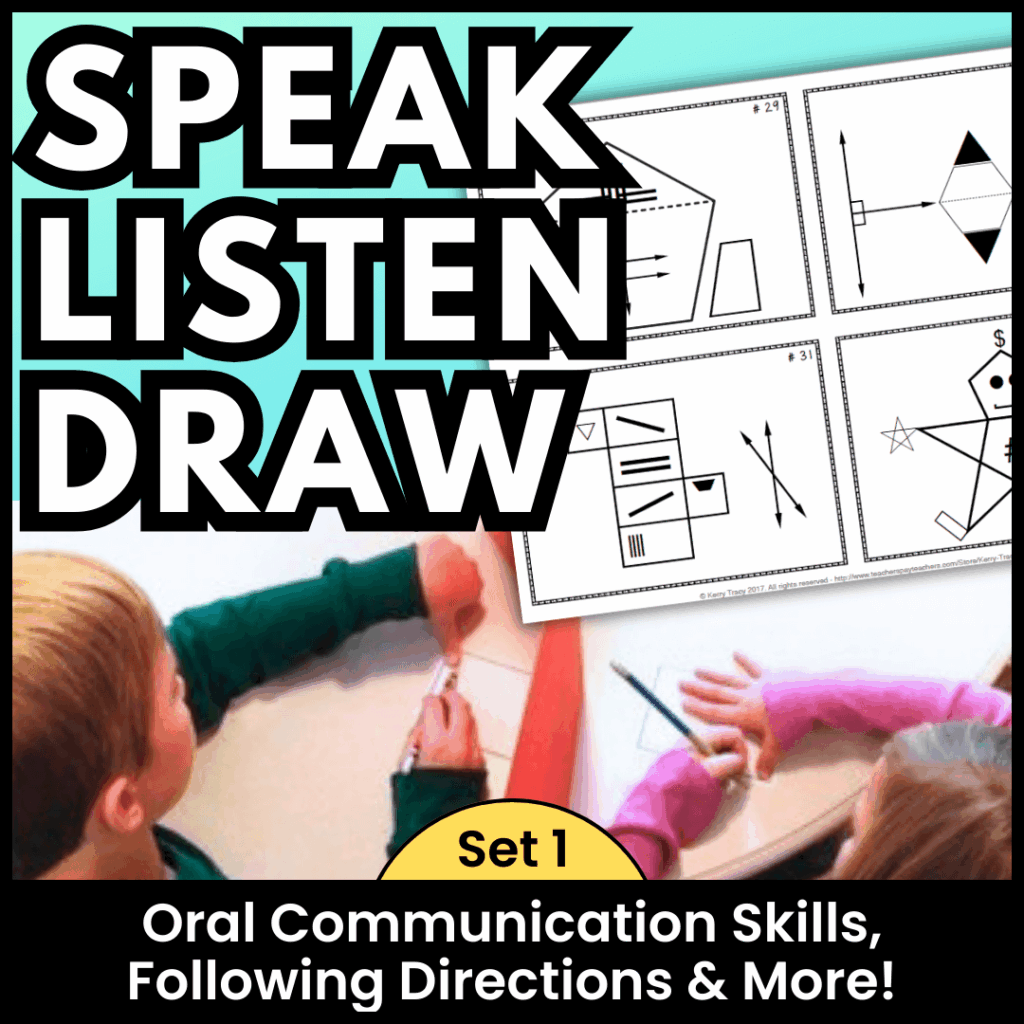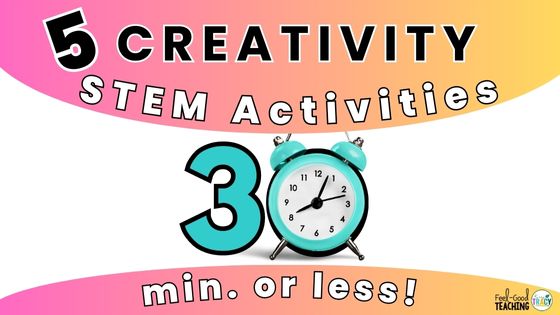My ideal situation for STEM sub plans is as few materials as possible — ideally just paper & pencil. This keeps things simple for the sub, doesn’t leave a chaotic mess when you return, and hopefully prevents any STEM supplies from going missing while you’re away!
With all that in mind, we still want activities to be STEM-focused, right? We want those brains firing on the 4 Cs of Engineering and the Engineering Design Process whenever possible.
In no particular order (because any one of them could be my favorite based on the class, time of year and my mood 😂), here are my top 9 ideas for simple STEM sub plans.
Each description should include ages, materials & timing sections.
- Design Domino (no building materials needed – 📝 only)
- Stop the Story STEM™ (no building materials needed – 📝 & picture book only)
- STEM Improv™ (no building materials needed – 📝 only)
- Quick Builds (simple materials & 📝 )
- Analyze This vs. That (no building materials needed – 📝 only)
- STEM Center Rotations (no building materials needed – 📝 only)
- Speak, Listen, Draw (no building materials needed – 📝 only)
- Speak, Listen, Build (simple materials — blocks, craft sticks, note cards, etc.)
- Create a Challenge (no building materials needed – 📝 only)
STEM Sub Plans Idea 1: Design Domino
Materials Needed: Paper & Pencil
Ages: 3rd – 6th (could work for older & younger too)
In STEM Design Domino, students roll a domino (or die) to generate a unique animal + object design challenge — like creating a backpack for a kangaroo or a toothbrush for a shark! They then sketch, plan, and explain their designs, defining criteria and constraints and reflecting on how their design meets their animal’s needs — all with just paper and pencil. This is my go-to for STEM sub plans.
Timing:
As short as 10 minutes (sketch ideas w/o reflection), but can go a full class period with all the components added. And it’s great for. sub because even if they finish all the components before the end of class, just give them another design combination and start again!
Where to get it:
You can create your own cards (see this post to DIY), or grab the resource on TPT or my site below.
STEM Sub Plans Idea 2: Stop the Story STEM™
Materials Needed: Paper & Pencil and a picture book of your choosing (fairy tales work well for all ages)
Ages: 2nd – 6th (could work for older & younger too)
Activity:
This hands-on activity blends reading comprehension with the Engineering Design Process (EDP) to help students think critically and creatively as they design innovative solutions for characters in classic stories.
Timing:
Between reading the story and doing the activity, you’ll want at least 40 minutes. The beauty of this for a sub is that if they finish a design board for one idea before the class is over; they can simply move on to the next design idea & board to fill the time. Or if you’re open to it, students can use paper and tape to create design prototypes using their design boards.
Where to get it:
You can create your own (see this post to DIY), or grab the resource on TPT or my site below.
STEM Sub Plans Idea 3: STEM Improv™
Materials Needed: Paper & Pencil
Ages: 3rd – 6th (could work for older & younger too)
Activity:
In this STEM activity designed to boost creativity, flexibility, and communication skills, students randomly select an object, material and function. From there, students develop a design plan, answer guiding questions, and refine their ideas—no prototype building required (unless you choose to extend the activity). The combinations are wacky fun, like the one you see above: a trampoline made of swimming goggles that makes lemonade, so it’s sure to get students thinking creatively!
Timing:
As short as 10 minutes (sketch ideas w/o reflection), but can be extended with the included reflection sheets, sharing with peers, building a paper & tape prototype, and doing multiple design combinations to fill as much time as you need.
Where to get it:
Grab the resource on TPT or here on my site below.
STEM Sub Plans Idea 4: Quick Builds
Materials Needed: Up to 5 simple materials (think: note cards, paper, tape, etc.) plus paper & pencil
Ages: 3rd – 6th (could work for older & younger too)
Activity:
Designed to be completed in 15-20 minutes with 5 or fewer simple materials like index cards, paper clips & tape, each quick build allows students to focus on hands-on building without going through the full engineering design process (EDP). Students select from two challenge options, ensuring built-in differentiation and engagement. Quick Builds are to the EDP what quick writes are to the writing process!
Timing:
As short as 15-20 minutes, but can be extended with the reflection page, sharing with peers, or doing both challenge options. This set comes with 45 challenges, so you are set for STEM sub plans all year and then some!
Where to get it:
Grab the resource on TPT, Etsy or my site below.
STEM Sub Plans Idea 5: Analyze This vs. That
Materials Needed: Paper & Pencil
Ages: 3rd – 6th (could work for older & younger too)
Activity:
Students analyze two, three, or four real-world designs that solve a similar problem. They will identify the problem solved, identify strengths & weaknesses of both designs, list potential research questions & more.
Timing:
Approximately 5-10 minutes per image and can be extended by sharing with peers. This set comes with 54 images, so you’ll be set for a long time!
Where to get it:
Create buckets/bags of items to analyze, or grab the resource on TPT below.
STEM Sub Plans Idea 6: STEM Center Rotations
Materials Needed: Paper & Pencil
Ages: 3rd – 6th (could work for older & younger too)
Activity:
Use a week’s worth of creativity & critical thinking bell ringer activities to cover single sub day. Activities include STEM Improv, Would You Rather STEM, 8 Ways to Use (Creativity), Analyze This vs. That and See-Notice / Think-Wonder. What’s great about these is they’ll work for bell ringers, centers, early finishers, choice boards — and definitely STEM sub plans!
Timing:
Each activity takes ~5-10 minutes, so a week’s set takes 25-50 minutes (use included options for early finishers to extend the time). This resource comes with 44 weeks of bell ringers along with some seasonal bonuses, so a sub won’t run out.
Where to get it:
Grab the resource on TPT or my site below.
STEM Sub Plans Idea 7: Speak, Listen, Draw
Materials Needed: Paper & Pencil
Ages: 3rd – 6th (could work for older & younger too)
Activity:
Students work in pairs: one creates & gives directions for their printed image, and the other listens and draws. Afterward, they compare the image to the drawing to evaluate how clearly directions were communicated. It’s a fun and effective way to build essential skills while supporting math, language, and SEL goals.
Timing:
As short as 10 minutes, but can be extended with having students write out directions for each other, doing additional images, or having students create their own images & “perfect” written directions for peers. This original set comes with 44 images and the winter version with 56 images, so a sub will never run out.
Where to get it:
You can create your own cards (see this post to DIY), or grab the resource on TPT below.
STEM Sub Plans Idea 8: Speak, Listen, Build
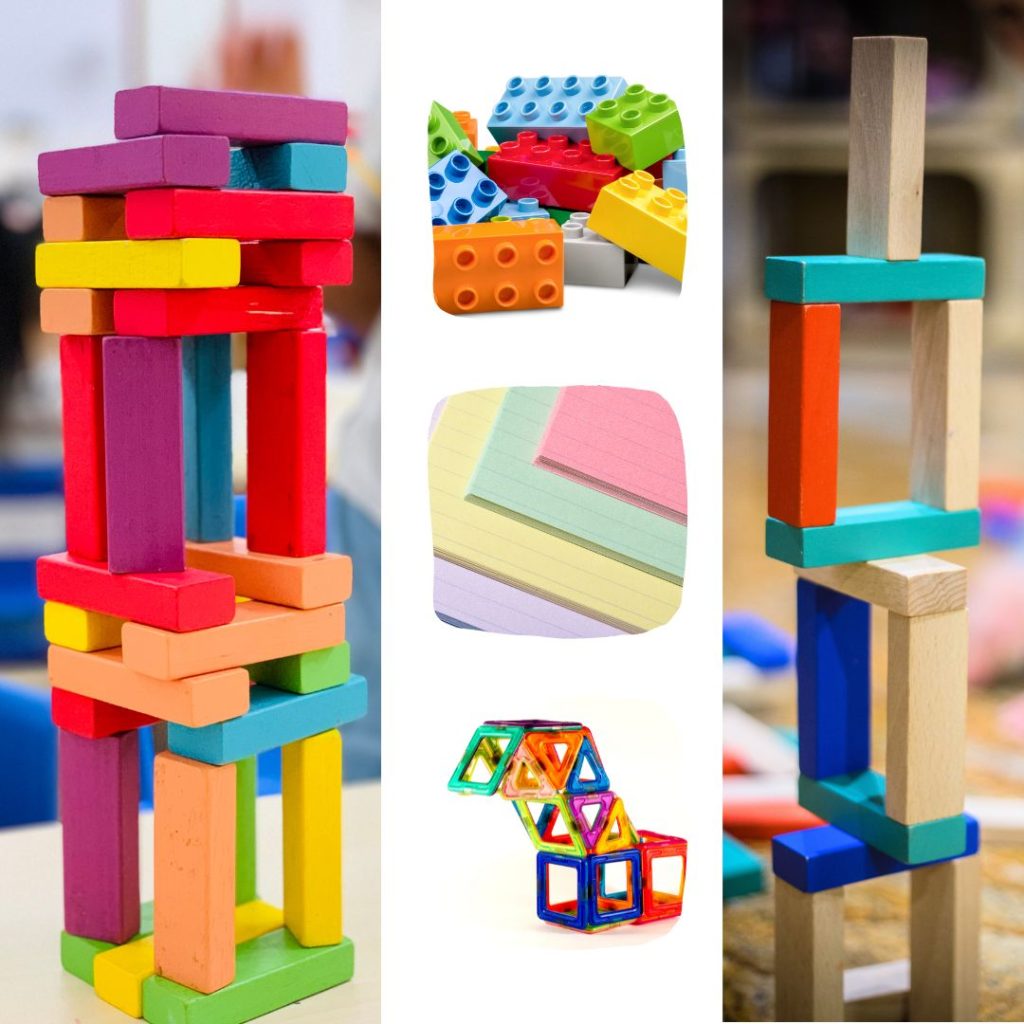
Materials Needed: Blocks, LEGO®, Keva Planks, index cards, etc.
Ages: K – 6th (could work for older students too)
Activity:
This is similar to Speak, Listen, Draw, but in this case one student will use simple building materials to create a structure or design, hidden behind a folder. They’ll then describe their design to a partner with the same set of building materials to see if they can get a perfect match.
Timing:
Approximately 10-20 minutes for each pairing.
Where to get it:
This comes straight from the students’ builds, so give it a try to see how it goes!
STEM Sub Plans Idea 9: Create Your Own Challenge
Materials Needed: Paper & Pencil
Ages: 3rd – 6th (could work for older too)
Activity:
Have students create their own STEM Challenge – perhaps to solve a problem at school (e.g. not enough storage for our STEM Challenge builds) or to create a fun activity for Fun Friday (create a new toy or PE game).
Timing:
Approximately 20 minutes, but can be extended by sharing with peers, or building paper & tape prototypes.
Where to get it:
I haven’t created a formal resource or blog post for this yet. I would simply leave behind a template for a criteria & constraints list like the one in Stop the Story STEM™ and have them brainstorm problems in their school, community or home they’d like to create a challenge for and have them fill out the criteria & constraints. This one should definitely be tried with you before leaving it in your STEM sub plans. (See the next section.)
How to Make Your STEM Sub Plans More Effective
No matter the activity you want to leave behind for a sub, it will work a million times better if your students have had exposure to the activity before your absence. So start cycling some of these activities into your bell ringers, center rotations & early finisher choice boards ASAP when you’re there to support them. The when your sub steps in and uses your STEM sub plans, it will go that much smoother!
Related Posts:
- Low Prep STEM: Design Domino
- Elevating the World of STEM Read-Alouds: Stop the Story STEM
- Speak-Listen-Draw Communication
- 30 STEM Activities in 30 Minutes or Less
Pin Me



